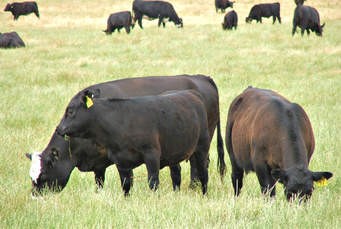Is your livestock enterprise profitable?
 PRODUCTION ADVICE - MARCH 2021 - THE BUSINESS OF FARMING
PRODUCTION ADVICE - MARCH 2021 - THE BUSINESS OF FARMING
By Adrian Smith
Senior Land Services Officer - Mixed Farming Systems
P: 03 5881 9932 | M: 0447 778 515 | E: adrian.smith@lls.nsw.gov.au
* This is an updated and expanded version of an article that first appeared in Production Advice in September 2020. It contains new information and greater detail.
 If you’re a Riverina livestock producer, the last 6-10 months should have been a boom time … shouldn’t it?
If you’re a Riverina livestock producer, the last 6-10 months should have been a boom time … shouldn’t it?
If we were to take at face value what’s been pretty good seasonal conditions, coupled with near record prices (at least for cattle), then we could possibly say there might not be a better time to be a producer of meat (and wool).
Notwithstanding that drought and bushfires are still fresh in producers’ minds, and issues still exist around coronavirus, then yes, as a livestock producer, things are pretty good!
Not wanting to ‘rain on the parade’, but as a producer, do you really know how your livestock enterprises are performing? If we are living in this ‘utopia’ at the moment, we should be doing everything we possibly can to make the most of these good times.
As a livestock producer, there’s no doubt there is a degree of satisfaction and pride in producing healthy, high-quality animals. And while most producers have a real passion and even ‘love’ for their livestock, at the end of the day, we can’t continue if we are not making a profit.
What are the drivers of profitable livestock businesses?
No matter what the enterprise, there are a number of critical things that drive profitable livestock businesses – these mainly revolve around the quantity (and quality) of the product you sell, and what it has cost you to produce it.
Not rocket science by any stretch … but do you know specifically how your business, and the enterprise(s) within it, are performing?
While the price you receive for what you produce is important, it is not the main driver of profitability. The key factors driving profitable livestock enterprises are:
- Stocking rate (top producers typically have higher stocking rates – around 5-10%)
- Weaning rate (the result of higher lambing/calving %, and lower mortality)
- Growth rate (combination of animal performance and pasture quantity and quality)
- Cost of production (top producers know how much it costs to producer each kg of product, are generally in the lowest 20 per cent regarding production costs, and typically run more stock per labour unit).
These factors are all directly within the remit of each individual producer. And while there is a range of things beyond our control (such as drought, flood, rainfall etc), it is important not to focus on these – but manage and improve those things that we can control.
The business imperative is to produce as much beef, lamb, wool, chevon or whatever from each hectare of your property at the least cost.
And while every business is unique, and varies according to location, natural resources, availability of capital, propensity to take on risk, family issues and the like, it is really important to understand these key drivers of profit are universal.
Do you know how your livestock enterprises stacks up?
A really valuable piece of work completed by consultants Holmes and Sackett for Meat and Livestock Australia (MLA) showed that in 2015-16, the top 20 per cent of prime lamb enterprises achieved an average profit of $25/DSE, which was 150 per cent more than the average enterprise. Similar statistics are true for beef producers.
So, where does your business fit? Are you a top 20 per cent producer? Are you some where in the middle? Or do you (like most of us!) not really know?
While your accountants and financial advisors can provide you with valuable insights into how your business(es) are performing, the real value comes when you benchmark yourself against other producers. This can be challenging (from a range of perspectives) but will ultimately provide you and your business with the information needed to improve profitability.
An important characteristic of top producers is that they generally ‘measure to manage’ their farm businesses – for example, they will have a good handle on their pasture base (measuring pasture production and composition), they will know the feed requirements of their livestock, they will be pregnancy testing or scanning to identify non-performing females and for allocating different feeding regimes, and so on. If you can’t identify how things are going, how can you make the necessary changes to your management and practices?
But the good news for those who aren’t one of the top 20 per cent is that by gaining a better understanding of your business, it can allow you to identify any shortcomings, and, importantly, implement changes that can take you to the ‘next level’ in terms of your business performance, and enjoy all the benefits this can bring!
Farming in a variable climate is a challenge
Producing livestock in a highly variable climate can prove really challenging – often when feed is plentiful, you aren’t running enough livestock. And the converse can be true – not enough feed in the paddock, too many mouths to feed!
When coupled with proactive decision-making and management practices, flexibility can often be the key to maintaining a profitable livestock business in a variable environment. Implementing strategies that you can quickly adjust or adapt to the vagaries of a particular season are essential to maintaining profitability, managing your livestock and land, and just as importantly, your own health and well-being.
I recently attended a webinar looking into these issues, organised by Agriculture Victoria and presented by industry consultant, Dr Jason Trompf. from Lambs Alive. Some things which Jason highlighted include:
1. Know your enemy – know how climate variability impacts your individual farm business (eg. How does variable rainfall affect your pasture production?).
2. Adjust your focus – build in some flexible systems and strategies you can use to cater for seasonal variability. (eg. containment feeding infrastructure).
3. Hit your targets – you need to set some targets or ‘non-negotiables’ that you need to meet regardless of the season (eg. reproductive performance such as lambing percentage).
4. Dodge a bullet - Have a series of tactics in place to deal with extremes. Remembering extreme events (such as fire, flood, death) will have the greatest impact on your business.
Farm businesses that have this flexibility, and can adapt quickly to changing circumstances, are generally well placed to remain sustainable and profitable.
What to do next?
Gaining a greater understanding of how your business performs might sound a little overwhelming – but it doesn’t have to be.
Once you have developed this sound knowledge of your own business, it can often lead to changes in the way you manage your business, and make it more pleasurable as well as more profitable! There is a saying – ‘work on your business rather than in your business’ – which simply means investing some time and energy understanding what makes your business tick rather than spending more time on the ‘day-to-day’ stuff!
Talk with your accountants and financial planners as a starting point – you will find that a lot of the information you need to start analysing your business already exists. You just need to invest some time!
Consider becoming a member of a local group of like-minded producers – this can often take you outside your comfort zone – but there is nothing more valuable than comparing and seeing how and what other producers are doing better or differently.
And finally, talk to your industry representatives – organisations such as MLA have a wealth of information that can help you become more profitable and operate a more successful farm business.
That ‘utopia’ mentioned at the outset may be a little outside our grasp – but gaining a greater insight into how your business and enterprises(s) perform can empower you to take your business to the next level, improve its performance and, importantly, provide the opportunity to maximise the enjoyment and satisfaction you get out of running a successful livestock business.